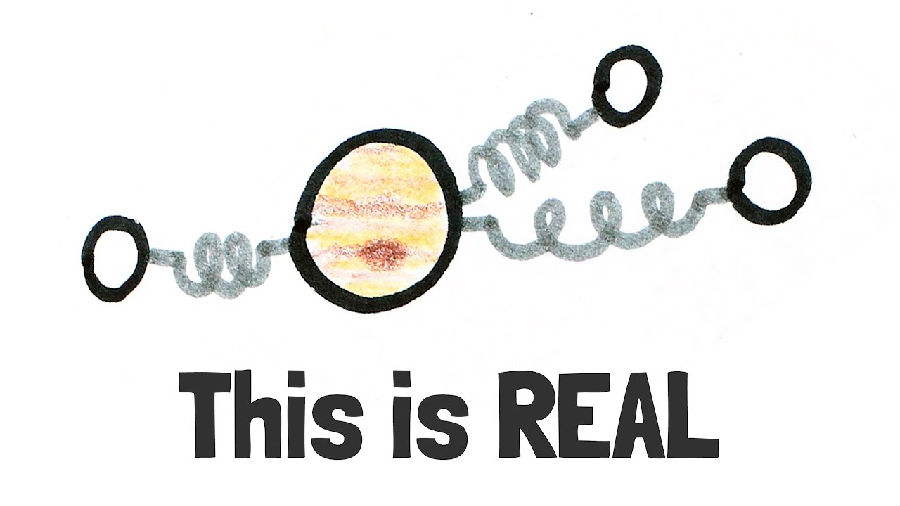When Galileo pointed his telescope at Jupiter in 1610, he was the first person to see the giant orbs attached to it by springs.
1610年,当伽利略将望远镜对准木星时,他是第一个看到由弹簧连接在木星上的巨大球体的人。
His actual drawings, compared night after night, show these bright spots moving back and forth past Jupiter,
他的手绘图,经过对每夜进行对比,表明这些亮点在木星周围来回移动,
exactly the same as if they were balls hanging off of springs. I mean, yeah Galileo was looking at the moons of Jupiter,
和挂在弹簧上的球一样。我是说,没错,伽利略是在观察木星的卫星,
but if you plot their motion back and forth and back and forth over time, it forms a sine wave.
但如果你画出它们随时间的来回运动,它会形成一个正弦波。
And that motion is mathematically identical to the motion of something
这种运动在数学上和一个物体在弹簧上
bouncing up and down on a spring with a linear restoring force - also sine waves over time.
以线性恢复力(随时间变化的正弦波)上下弹跳的运动是一样的。
From a side-on perspective that projects two dimensions down to one,
从物体二维降到一维的侧面看,
things in circular orbits look exactly like they're springing back and forth on giant coils of wire.
在圆形轨道上的物体看起来就像在巨大的线圈上来回弹跳。
Now, I'm not saying that we should think of the moons of Jupiter as being held on by giant invisible springs,
我不是说我们应该认为木星的卫星是由巨大的看不见的弹簧支撑着,
but it's a valid mathematical model when viewing them from a distance –
但当我们从远处观察它们时,它是一个有效的数学模型—
it'll make the same predictions about the motions of the moons as the "orbiting in circles due to invisible gravity" model,
它将对月球的运动做出与“由于看不见的引力而绕圈运行”模型相同的预测
and one can be mathematically transformed into the other.
并且在数学上来讲,一个可以转化成另一个。
The moons of Jupiter aren't alone in having multiple mathematical descriptions:
木星的卫星并不是唯一一个拥有多重数学描述的:
projectiles and storms on earth experience a force (called the Coriolis effect) that causes them to turn,
地球上的抛射物和风暴会经历一种力(称为科里奥利效应),使它们转移,

but viewed from an external perspective, the projectiles and storms are what goes in a straight line while the earth turns beneath them.
但是从外面角度来看,当地球在它们下面转动时,抛射物和风暴是沿着一条直线运动的。
Both models, if you use them carefully, make correct predictions about reality.
如果仔细运用,这两个模型都能准确预测现实。
And quantum phenomena can be modeled in at least three different ways that all give the same predictions:
量子现象至少可以用三种不同的方式建模,它们都给出了相同的预测:
as a particle being guided by a spread-out "pilot wave", or as a spread out probability wave that collapses to a single point,
作为一个被展开的“导波”引导的粒子,或是一个折叠成一个点的展开概率波,
or as a particle exploring all possible paths it could take and interfering with itself along the way.
又或者是一个探索所有可能的路径,并在这个过程中干扰自己的粒子。
All three of these mathematical models suggest different ways of thinking about what's "actually" going on in quantum mechanics,
所有这三种数学模型都提出了不同的方式来思考量子力学中到底发生了什么
and the fact that all of them give the same experimental predictions suggests that
三种方式都给出了相同的试验性预测表明
perhaps none of them is the "right" way to picture what's happening in quantum systems.
也许没有一个是描绘量子系统的“正确”方式。
Mathematical models give us nice, easy-to-digest pictures of how the universe works:
数学模型给我们提供了很好的、容易理解的宇宙运行的画面:
moons orbit around planets, atoms bind together into molecules, electrons are clouds of probability, and so on.
卫星绕着行星运行,原子结合成分子,电子是概率云,等等。
But we need to be careful how much weight we give to the models in our heads (or on our blackboards, or computer screens).
但我们需要注意我们的头脑(或黑板或电脑)给了这些模型多大的分量。
Do Jupiter's moons move like they're pulled back and forth by the invisible force of springs?
木星的卫星移动起来是否像被无形的弹簧拉来拉去?
Or held in orbits by the invisible force of gravity? Or are they following helical paths which are actually straight lines in curved spacetime?
还是被无形的地心引力控制在轨道上?它们是沿着在弯曲时空中实际上是直线的螺旋路径移动吗?
The way we describe the world influences the way we think the world is,
我们描述世界的方式影响着我们看待世界的方式,
even when there are other, equally correct ways of describing the world that paint entirely different pictures from our own.
即使存在其他同样正确的描述世界的方式,但它们描绘的画面与我们的完全不同。
That's not to say we should accept wrong ideas, but we should be aware that sometimes a different correct picture,
这并不是说我们应该接受错误的想法,而是我们应该意识到有时一个不同的正确的画面
one we haven't considered, is the one we need to see.
一个我们没有考虑过的想法,就是我们需要看见的。













